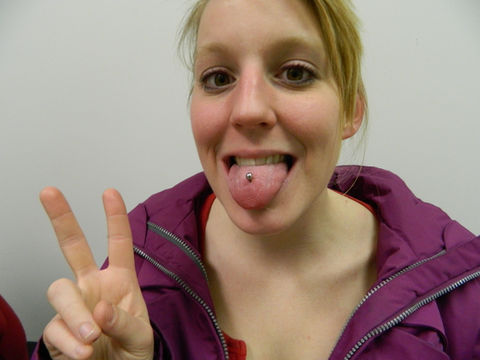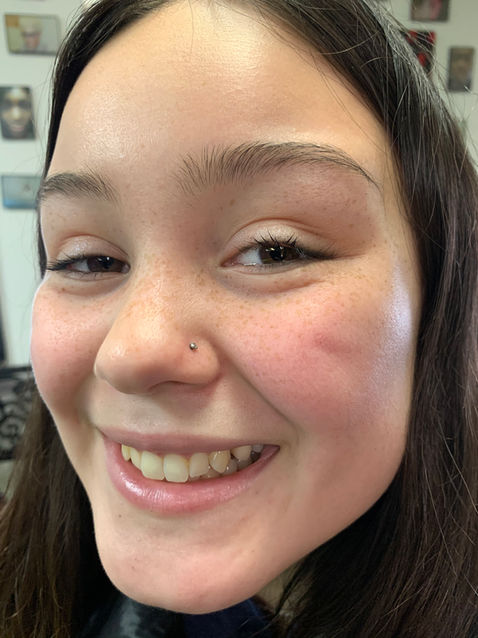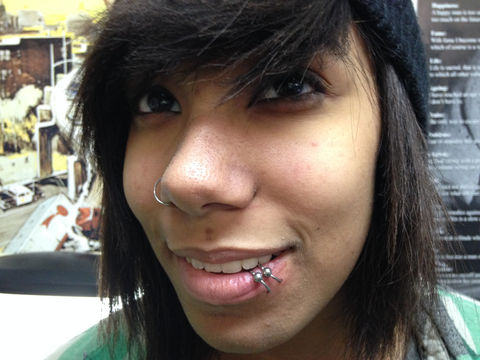PIERCING AFTERCARE
....................
Do you have healing concerns?
Come in ASAP!
We can talk about what you’re experiencing, what causes it, and what you can do about it. We can also provide a troubleshooting guide, an irritated piercing aftercare sheet, and sample products to help soothe your piercing. You’re welcome to email pictures first but know you will probably need to come in.
Do you suspect infection?
See a doctor ASAP!
Symptoms of infection include swelling, pain, hot, very red or dark, blood or green goo, feeling unwell or you’re developing a fever.
BODY AFTERCARE
....................
DAILY TO DO’S
1. Wash your hands thoroughly prior to cleaning or touching your piercing.
2. Spray sterile saline wound wash while healing 2 times daily. Moving or rotating the jewelry is not necessary during cleaning/rinsing and may actually irritate the piercing.
3. Remove crust from skin and jewelry daily two times per day gently remove all crust with a wet q-tip.
4. Dry area with clean, disposable products like gauze, cotton swabs, tissue, or paper towels. Cloth towels should be avoided as they can harbor bacteria and snag on jewelry.
5. Check jewelry ends daily so your jewelry doesn’t fall out. Threadless is a snap fit. Threaded screws together. Righty tighty, lefty loosey.
6. Downsize jewelry after 6 - 8 weeks - Starting with longer jewelry accommodates for swelling and allows your piercing to drain. Failure to downsize on time may cause shifting of jewelry, bumps, and prolonged healing.
DON'T DO'S
Don’t touch without washing hands to reduce risk of infection.
Don’t be too rough. Excess pressure, snagging, or bumping your piercing will cause swelling, bleeding, shifting, bumps, and prolonged healing.
Don’t take your jewelry out - Your piercing will shrink within minutes and heal together very quickly.
Don’t change jewelry too frequently while healing. Get assistance from a professional piercer to ensure the jewelry change is done gently, with higher quality implant grade jewelry, and in the correct size for your unique anatomy. Jewelry is not a one size fits all.
Don’t use harsh products on your piercing - Products such as Alcohol, Peroxide, Hibiclens, Witch hazel, Tea tree oil, Bactine, Ear care solution, Dial soap, & Ointments are too harsh and may slow or prevent healing.
Don’t get personal products in your piercing - Make-up, Lotion, Face wash, Hair products, etc. are too harsh and may slow or prevent healing.
Don’t submerge piercing in open bodies of water for 6 - 8 Weeks - Microorganisms in pools, hot tubs, lakes, and the ocean may lead to infection. Waterproof bandaids are available at the pharmacy.
Don’t take random advice from non-professionals such as Dr. Google - Come in during business hours or email Jamie if you have questions.
ORAL & BODY AFTERCARE
....................
DAILY TO DO’S
1. Wash your hands thoroughly prior to cleaning or touching your piercing.
2. Spray sterile saline wound wash while healing 2 times daily. Moving or rotating the jewelry is not necessary during cleaning/rinsing and may actually irritate the piercing,
3. Remove crust from skin and jewelry daily two times per day gently remove all crust with a wet q-tip.
4. Dry area with clean, disposable products like gauze, cotton swabs, tissue, or paper towels. Cloth towels should be avoided as they can harbor bacteria and snag on jewelry. Drying the area is not necessary for tongue piercings.
5. Check jewelry ends daily so your jewelry doesn’t fall out. Threadless is a snap fit. Threaded screws together. Righty tighty, lefty loosey.
6. Downsize jewelry after 4 weeks. Starting with longer jewelry accommodates for swelling and allows your piercing to drain. Downsize the length of your jewelry as suggested to avoid shifting, bumps, and prolonged healing.
7. Take an anti-inflammatory to reduce swelling and minimize discomfort. Use as directed; if not medically contraindicated.
8. Rinse With Alcohol Free Mouthwash 3 times daily.
9. Drink Cold Water. Soothe your piercing with ice cold water or ice chips.
DON'T DO'S
Don’t touch without washing hands to reduce risk of infection.
Don’t be too rough. Excess pressure, snagging, or bumping your piercing will cause swelling, bleeding, shifting, bumps, and prolonged healing.
Don’t take your jewelry out. Your piercing will shrink within minutes and heal together very quickly.
Don’t change jewelry too frequently while healing. Get assistance from a professional piercer to ensure the jewelry change is done gently, with higher quality implant grade jewelry, and in the correct size for your unique anatomy. Jewelry is not a one size fits all.
Don’t use harsh products on your piercing. Products such as Alcohol, Peroxide, Hibiclens, Witch hazel, Tea tree oil, Bactine, Ear care solution, Dial soap, & Ointments are too harsh and may slow or prevent healing.
Don’t get personal products in your piercing. Make-up, Lotion, Face wash, Hair products, etc. are too harsh and may slow or prevent healing.
Don’t submerge piercing in open bodies of water for 6 - 8 Weeks. Microorganisms in pools, hot tubs, lakes, and the ocean may lead to infection. Waterproof bandaids are available at the pharmacy.
Don’t take random advice from non-professionals such as Dr. Google. Come in during business hours or email Jamie if you have questions.
No Smoking or Drinking Alcohol. May increase swelling and cause complications.
Avoid Foods With Big Bites. Such as pizza, burgers, subs etc.may be uncomfortable to eat. Go easy and by comfort.
Avoid Hot & Spicy Foods. Hot and spicy foods may sting and burn your new piercing.
Avoid Acidic juices and acidic beverages initially as they may sting.
TONGUE AFTERCARE
....................
DAILY TO DO’S
1. Wash your hands thoroughly prior to cleaning or touching your piercing.
2. Take an anti-inflammatory to reduce swelling and minimize discomfort. Use as directed; if not medically contraindicated.
3. Rinse With Alcohol Free Mouthwash 3 times daily.
4. Drink Cold Water. Soothe your piercing with ice cold water or ice chips.
5. Check jewelry ends daily so your jewelry doesn’t fall out. Threadless is a snap fit. Threaded screws together. Righty tighty, lefty loosey.
6. Downsize jewelry after 3 - 4 weeks. Starting with longer jewelry accommodates for swelling and allows your piercing to drain. Downsize the length of your jewelry as suggested to avoid shifting, bumps, and prolonged healing.
DON'T DO'S
Don’t touch without washing hands to reduce risk of infection.
Don’t be too rough. Snagging your piercing or playing with your jewelry your piercing may cause swelling, bleeding, bumps, tearing, and prolong healing.
Don’t take your jewelry out. Your piercing will shrink within minutes and heal together very quickly.
Don’t change jewelry too frequently while healing. Get assistance from a professional piercer to ensure the jewelry change is done gently, with higher quality implant grade jewelry, and in the correct size for your unique anatomy. Jewelry is not a one size fits all.
Don’t use harsh products on your piercing. Products such as Mouthwash with Alcohol, Peroxide, Glyoxide, or Ointments because they are too harsh and may slow or prevent healing.
No Smoking or Drinking Alcohol. May increase swelling and cause complications.
Avoid Foods With Big Bites. Such as pizza, burgers, subs etc.may be uncomfortable to eat. Go easy and by comfort.
Avoid Hot & Spicy Foods. Hot and spicy foods may sting and burn your new piercing.
Avoid Acidic juices and acidic beverages, they may sting initally.
Don’t take random advice from non-professionals such as Dr. Google. Come in during business hours or email Jamie if you have questions.
Aftercare suggestions are based on training, research, and professional experience. Any suggestions should not be a substitute for medical advice from a physician. If you suspect an infection make an appointment with your doctor as soon as possible!











